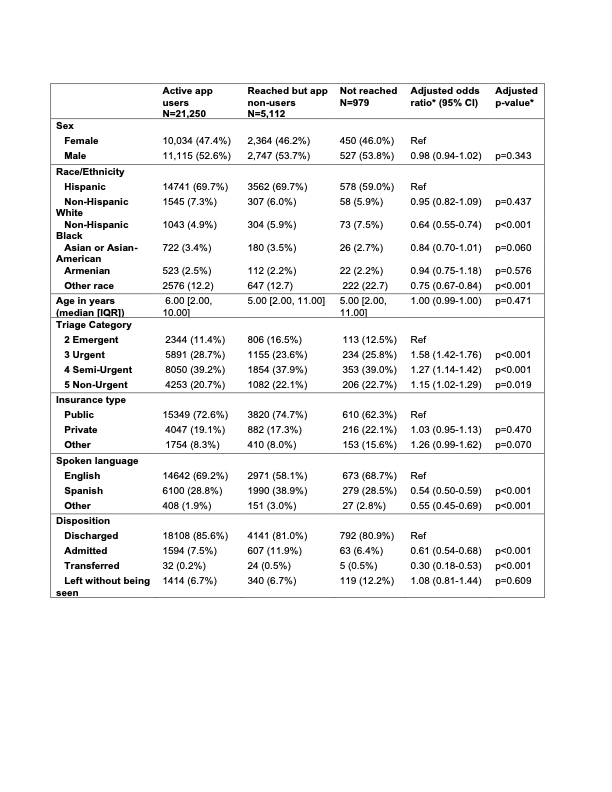Emergency Medicine 1
Session: Emergency Medicine 1
419 - Race/Ethnicity and Language Disparities in Adoption of a Digital Patient Navigation Application in the Pediatric Emergency Department
Friday, April 25, 2025
5:30pm - 7:45pm HST
Publication Number: 419.6190
Anna McGinty. Cushing, Children's Hospital Los Angeles, Los Angeles, CA, United States; Jeanine E. Hall, Children's Hospital Los Angeles, Los Angeles, CA, United States; Arshad J. Jiffry, Children's Hospital Los Angeles, Los Angeles, CA, United States; Ameer P. Mody, Children's Hospital Los Angeles, Los Angeles, CA, United States
- AC
Anna McGinty Cushing, MD (she/her/hers)
Pediatric Emergency Medicine Physician
Children's Hospital Los Angeles
Los Angeles, California, United States
Presenting Author(s)
Background: Waiting to obtain care in the pediatric emergency department (ED) is a uniquely stressful event for patients and families. Digital apps can improve communication and provide status updates about patients' care plan during their visit. Introduction of new technology carries risk of unequal adoption influenced by factors such as spoken language and access to a capable smartphone. It is essential to ensure all patients have access to tools that enhance the quality of their ED experience.
Objective: Our objectives were to (1) describe reach and acceptability of a new digital patient-facing care ED navigation app and (2) evaluate app adoption by demographic and clinical factors.
Design/Methods: We performed a cross-sectional study of patients presenting to an academic pediatric ED in the first 5 months of app implementation (February 7, 2024 - June 30, 2024). Visits were excluded for critical illness or a socially sensitive reason for visit. We categorized patients as: active app users, reached but app non-users, and not reached. Among reached patients, we performed univariable association between demographic and clinical factors and app use. We evaluated differences in app use during hours in which a bilingual (English/Spanish) in-person patient navigator was present to facilitate app use. We derived a multivariable logistic regression model to identify demographic and clinical factors associated with app use.
Results: Of 27,241 included patients, 96.4% were reached and 77.6% used the app. Among active app users, 492 (2.3%) responded to the in-app survey. Median app satisfaction was 5/5. Race/ethnicity, preferred language, and insurance were all associated with app use. During hours when a bilingual patient navigator was present, Spanish-speaking (79.3% with navigator, 73.4% without, p< 0.001) and English-speaking patients (85.6% with navigator, 81.9% without, p< 0.001) had higher rates of app use, with no difference for other language speakers. In a multivariable model, Spanish-speaking (adjusted odds ratio (aOR) 0.54, 95% CI 0.50-0.59) and other language speaking patients (aOR 0.55, 95% CI 0.45-0.69) and those who were non-Hispanic Black (aOR 0.64, 95% CI 0.55-0.74) or other race (aOR 0.75, 95% CI 0.67-0.84) has lower odds of app use (Table 1).
Conclusion(s): Most patients utilized the patient navigation app to enhance their ED experience. However, patients of minoritized race and non-English speakers were less likely to use the app. Presence of a staff member to facilitate access improved adoption. These findings will inform future interventions to ensure all patients have equitable access to digital tools.
Table 1. Clinical and Demographic Characteristics of Patients by App Usage Category.
 Patients were categorized into 3 app usage categories: Active app users are families who had any app use during the study period. Reached but app non-users are families where a text message link to the app was received but the family never used the app. Not reached are families where a text message link to the app was unable to be completed due to an invalid or incorrect number or a phone without capability to receive the message. Patient characteristics and in-app satisfaction survey response are reported for the first visit for each patient within their usage category (e.g. first visit with app use for patients categorized as active app users).
Patients were categorized into 3 app usage categories: Active app users are families who had any app use during the study period. Reached but app non-users are families where a text message link to the app was received but the family never used the app. Not reached are families where a text message link to the app was unable to be completed due to an invalid or incorrect number or a phone without capability to receive the message. Patient characteristics and in-app satisfaction survey response are reported for the first visit for each patient within their usage category (e.g. first visit with app use for patients categorized as active app users).*Comparison is between active app users and reached but app non-users only.

